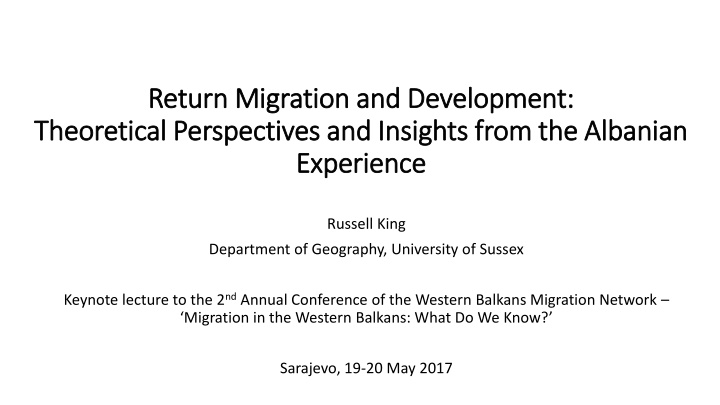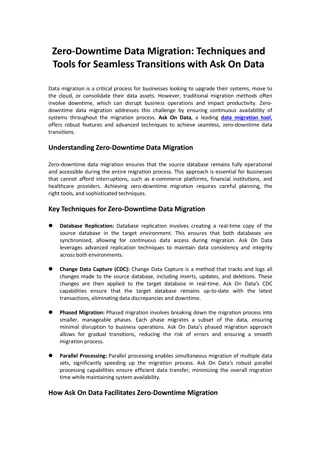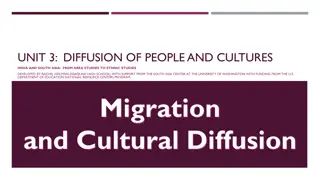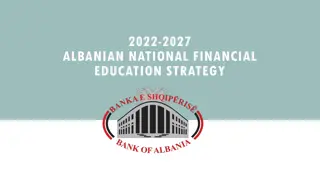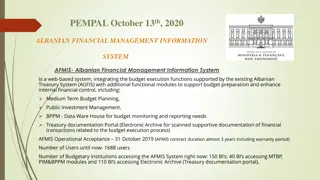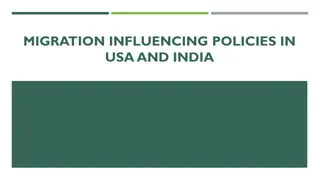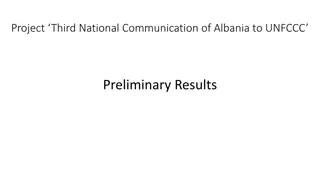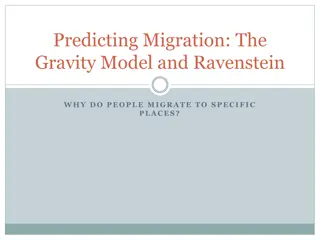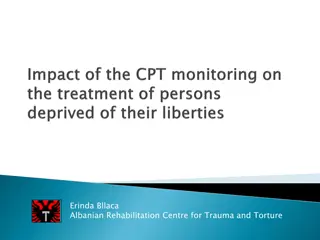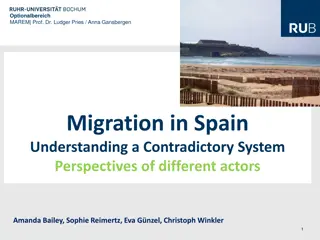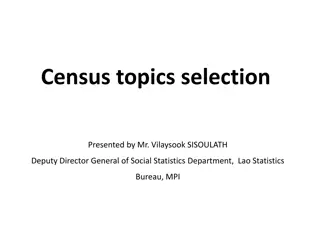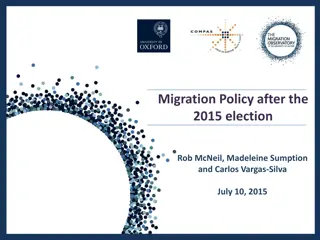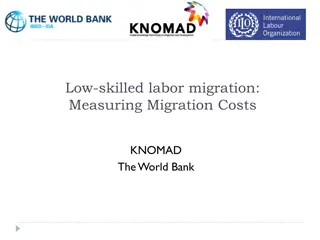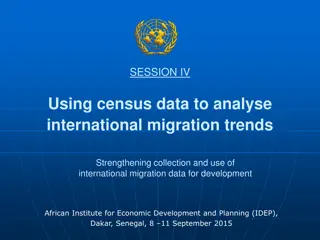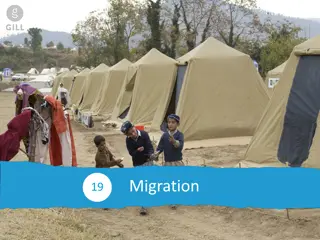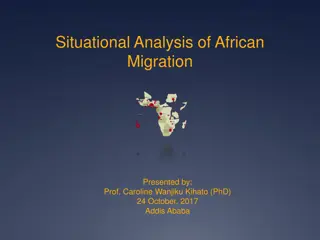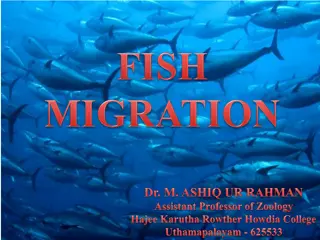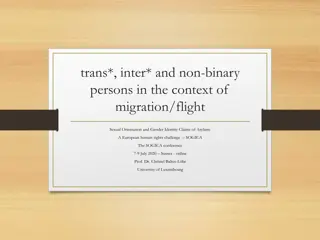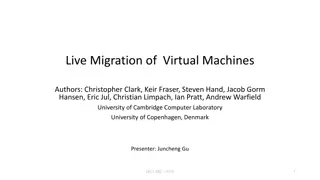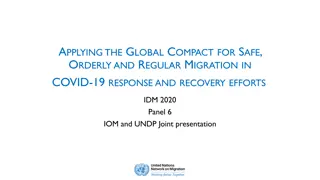Return Migration and Development: Theoretical Perspectives and Insights from the Albanian Experience
Keynote lecture by Russell King at the 2nd Annual Conference of the Western Balkans Migration Network discussing the relationship between return migration and development. Topics include definitions and measures of migration and development, unpacking the migration-development nexus, theorizing return migration, and evidence from Albania on the impact of return migration on development.
Download Presentation

Please find below an Image/Link to download the presentation.
The content on the website is provided AS IS for your information and personal use only. It may not be sold, licensed, or shared on other websites without obtaining consent from the author.If you encounter any issues during the download, it is possible that the publisher has removed the file from their server.
You are allowed to download the files provided on this website for personal or commercial use, subject to the condition that they are used lawfully. All files are the property of their respective owners.
The content on the website is provided AS IS for your information and personal use only. It may not be sold, licensed, or shared on other websites without obtaining consent from the author.
E N D
Presentation Transcript
Return Migration and Development: Return Migration and Development: Theoretical Perspectives and Insights from the Albanian Theoretical Perspectives and Insights from the Albanian Experience Experience Russell King Department of Geography, University of Sussex Keynote lecture to the 2ndAnnual Conference of the Western Balkans Migration Network Migration in the Western Balkans: What Do We Know? Sarajevo, 19-20 May 2017
Outline of Presentation Outline of Presentation Migration and Development: definitions and measures Unpacking the Migration-Development Nexus: Root Causes vs the Migration Hump Where does Return Migration fit in? Typologies of Return Theorising Return Migration and its Relationship to Development Evidence from Albania: can return migration stimulate development? 2
Migration and Development: Definitions and Measures Migration and Development: Definitions and Measures Until recently the two interdisciplinary fields of Migration Studies and Development Studies remained separate: migration scholars said little about development ; and development specialists said little about migration. Debate on the Migration and Development Nexus only a decade old, since Van Hear and Nyberg S rensen s landmark collection (2002/3). But there are important definitional and measurement issues with the M How is migration defined and measured? Are we only concerned with international migration? Gross or net migration? Flows or stocks? Permanent, temporary or circular/seasonal migration? How is development defined and measured? Per capita real income? How about quality of life? Distribution of income/welfare? Human Development Index (per cap. income + life expectancy + education/literacy). Variations of HDI incorporate poverty, social exclusion, and gender. Recent conceptualisations of development focus on notions of wellbeing, happiness and freedom of choice. D nexus. 3
Unpacking the M Unpacking the M D Nexus D Nexus Two models of causality: MIGRATION DEVELOPMENT MIGRATION UNDERDEVELOPMENT or One is virtuous circle, the second is a vicious circle Further questions: Development for whom? Receiving country; sending country; migrants themselves? Does the nature of the M D relationship change over time? If so, over what periods of time? historical eras, or within the evolution of a single migration system. And do the dynamics of the M D relationship differ by scale (individual, family/household, community, region, country, international economic system)? 4
Key Questions about Migration and Development Key Questions about Migration and Development For this presentation, we are mainly concerned with migration from poor to richer countries, and the impact of this migration on the migrants countries of origin, for instance Albania or other Western Balkan countries. Back to the question of causality: does migration lead to (under)development, or is it the reverse case, (under)development leading to migration? One answer is that this kind of causality is impossible to infer, and that both are part of the same interactive process globalisation, global inequality, global social transformation etc. But this answer is too glib, and allows us to opt out of asking and answering certain realistic questions, which reflect the fact that migration events occur with particular intensity in certain conditions and at certain times. Five questions seem particularly relevant: 1. Does underdevelopment cause migration? Lots of evidence suggests so. 2. Does migration lead to further underdevelopment? Or 3. Does migration lead to development? Assuming it does, 4. Does development lead to less or further migration? Root causes vs. the hump . 5. Where does return migration fit in? 5
Root Causes vs. The Hump Root Causes vs. The Hump Migration the migration hump root causes High Development Underdevelopment 6
Where does Return Migration fit in? Where does Return Migration fit in? Return migration was once referred to as the great unwritten chapter in the history of migration (King 2000). Is this still true? Most research on migration is still conducted from the perspective of the host country and is mainly about immigration, integration, and ethnic communities . There is a kind of naturalist assumption about return migration that it is the natural thing for migrants to do, and that therefore their return home is unproblematic as that is where they really belong . In actual fact, the decision to return is much more finely balanced and complex than the preceding decision to emigrate in most cases. Moreover, there are many types of return, just as there are many types of migration by time-frame, intentions, causality and outcomes. 7
Types of Return by Time Periods Types of Return by Time Periods (1) OCCASIONAL/SHORT-TERM: Holidays, family visits etc. (2) PERIODIC/SEASONAL/CIRCULAR: Frontier and seasonal/circular workers. (3) TEMPORARY: Return for >1 year; intention to re-emigrate. (4) PERMANENT: No intention of re-emigration. 8
Return Migration: Intentions and Outcomes Return Migration: Intentions and Outcomes Migrants emigrate with the intention of returning, and do in fact return, e.g. targetmigrants Intended temporary emigration without return; return is continuously postponed until it never happens: myth of return . Intended permanent emigration with return: e.g. the myth of non- return (US or Australian immigration); or involuntary repatriation; or some personal disaster Intended permanent emigration without return; but after death? links with home? Ancestral return; Jews; 2nd and 3rd generation returnees 9
Causes and Motivations for RM Causes and Motivations for RM Like ordinary migration, return can be frameworked with a set of push (from the host country) and pull factors (from the country of origin) economic push from immigration country (unemployment, falling wages, rising costs of living); economic crisis economic pull from origin country (lower cost of living, desire to invest in a business or in property) hostility/discrimination in host country (push factor), plus nostalgia for home (pull factor); also desire for enhanced social and personal status back home family and life-cycle factors: retirement; need to care for aged parents; education of children; marriage lifestyle reasons more relaxed way of life, renewal of social and kinship networks; more healthy and genuine rural environment; better climate etc. political and policy factors: push factors from destination country (loss of regular status, return bonus schemes to incentivate return) and pull factors from origin country (resettlement grants, brain return incentives etc.) 10
The Cerase Model of Return Migration and Development The Cerase Model of Return Migration and Development RETURN OF FAILURE 0-5 years RETURN OF CONSERVATISM 5-15 years ----------------------------------------------------- RETURN OF INNOVATION 15-30 years RETURN OF RETIREMENT > 30 years NO RETURN (return after death?) } orientation to society of origin } orientation to society of destination after Cerase (1974), modelling Italian return migration from the US 11
Theorising Return Migration Theorising Return Migration 1 1 How can traditional or conventional theorisations of migration be applied to return? Cassarino (2004) proposes five frameworks: Migrants calculate costs vs. benefits of migration, mainly on basis of wage differentials, costs of living, and costs of moving. Return therefore represents failure of calculation of the benefits over costs balance. New economics of migration Here the household is the economic decision-making unit, with different members doing different things in different places in order to both maximise income and spread risk. Return therefore represents success of household members going abroad to earn income for the household economy. Neo-classical economics Note that this different outcome is also based on the neo-classical assumption of migration as permanent or long-term relocation, and the NELM s framing of migration as temporary of one (or more) members. 12
Theorising Return Migration Theorising Return Migration 2 2 Structural or neo-Marxist approach Migrants are pawns in the capitalist system; units of labour to be exploited by employers. Return therefore reflects the rejection or exhaustion of migrant workers, either due to their declining labour power or recession. Transnationalism Return seen as part and parcel of the circulatory system of transnational social and economic spaces. Transnational identities imply that returnees have, in a sense, never left in the first place. Social networks and systems Like TN, network and systems theory emphasises interconnections between home and destination ; return as feedbackloop ; cross-border social networks and social capital facilitate ease of return. After Cassarino (2004) 13
Migration in the Neoliberal Era: A Triple Migration in the Neoliberal Era: A Triple- -Win Scenario? Win Scenario? For the destination country extra supply of free labour , cheap and flexible, willing to do any job (3D jobs) boosts growth and competitiveness; increases consumer demand and tax revenues brings cultural and ethnic diversity multicultural society For the source country unemployment reduced; raises well-being of rest of the population generates remittances, important at household, community and national levels returning migrants bring back capital, training from abroad and new ideas ( social remittances ) For the migrants relief of unemployment and poverty; higher wages (worth more in home country) able to attain life targets build a house, buy land, invest in farm or business, pay health bills, educate children gain new experiences, broaden horizons etc. 14
But But it doesn t always work out this way it doesn t always work out this way For the receiving country immigrants take our jobs and drive down wages; fiscal burden of family migration; cultural difference seen as threat to national identity For the sending country emigration is socially and demographically selective; depopulation of some regions; brain/skill drain; over-reliance on remittances; returnees find it hard to re- integrate For the migrants dangers of migration (especially if irregular ); exploitation in 3D jobs; de- skilling; racism and discrimination; separation from family This leads to a more critical realist perspective, from two directions: A critique of the over-celebratory current discourse on migration and remittances as development from below by examining the micro-dynamics of migrants real lives, which often reveal exploitation, degradation, racism, criminalisation, fight for survival An ideological return to the structuralist/dependency school which critiques neoliberal globalisation. Migrants to be seen as structurally forced by the global power dynamics of increasing inequality and capital concentration, and as structurally marginalised by the geopolitics of migration control. 15
M D: Three Dimensions of Activity M D: Three Dimensions of Activity 1. Remittances: the main vehicle of the M Various kinds: financial, in-kind (gifts, goods), collective (eg. organised by HTAs), spiritual (for building churches, mosques, temples), social remittances (new norms and behaviours), also reverse remittances (eg. to support students abroad) Key issue is how they are spent: on survival , on conspicuous consumption , on investment in human capital (health, education), or on economic projects (irrigation, business enterprise etc.). What is impact of social remittances? D nexus, remittances mantra 2. Return: an old topic in migration studies, but needs re-examing Who returns and why? Voluntary vs. forced return. Are returnees successes or failures ? At what age do migrants return as economically active or as retirees? What development impulse can be expected? Re-skilled or de-skilled? Brain return? Investment in development? 3. Diaspora Involvement: the most recently popular aspect of the M D process If migrants cannot or don t want to return, get them involved at a distance through projects of co-development, investment and temporary visits. Transnational businesses. 16
The Albanian Case of Migration and Development The Albanian Case of Migration and Development Albania has shown itself to be a classic laboratory for the study of migration and development experienced against a virtual tabula rasa since 1990, and with one of the highest rates of emigration relative to its population size of any country in the world in recent decades. Few Albanian families unaffected by migration. Migration can be seen as a response to underdevelopment both to the long history of isolation and distorted development under the communist regime, and to the economic and political collapse and insecurity after 1990. Pulses of heavy emigration in 19991 (initial exodus), 1997 (pyramid schemes collapse) and 1999 (Kosovo crisis). Emigration continued in the new millennium but at decreasing intensity. Most Albanian migration has been to Greece and Italy (about 0.5 million in each), and was irregular or semi-regular initially, but settled by regularisations since the late 1990s, which facilitated family migration, family formation, and the second generation. Migration has been an effective solution to poverty and a rational and pragmatic strategy for survival and even achieving modest prosperity in some cases. Remittances are key to this both at the national level of shoring up the economy, and at the level of household micro-economies. Also evidence that remittances have fuelled internal migration to the Tirana-Durr s pole. 17
Return Migration Return Migration This is the great unknown in the study of Albanian migration: no systematic and robust data on returns apart from small-scale surveys, anecdotal evidence and personal observation. Return is certainly occurring, but on a limited scale. Interactions between remittances and return. Some remittance investments in a shop or building enterprise for instance are geared to a subsequent return. Once a return takes place, remittances stop. Plenty of non-systematic evidence that returnees are setting up micro-enterprises, especially in geographically and economically favoured areas. Some returns are regular or periodic, linked to seasonal work in farming in Greece or to other short-term work, or caused by repatriations of illegal workers. Many Albanian migrants have vague plans to return one day , but if they are engaged in family migration, this is unlikely to happen before retirement, if at all. On the whole, large-scale return is discouraged by the disorganised state of the Albanian economy, burdened by inefficiency, corruption and poor infrastructures. However, the severe economic crisis in Greece has led to lots of anecdotal evidence of significant return now taking place, and there has been a significant reduction in the stock of Albanians in Greece. 18
Conclusion: Migration, Return, and Economic Crisis Conclusion: Migration, Return, and Economic Crisis On a global scale, the effects of the economic crisis on migration stocks and flows have been surprisingly muted: reduced immigration flows, and some return migration. Albanian migrants in Europe have shown themselves to be flexible and adaptable during the crisis up to a point. They trade on their reputation as hard and good workers, and are willing to cut costs (if in business) or accept lower wages than native workers. They may move, partially or completely, back into the informal economy in order to survive, and as needs dictate. However, their options are not endless: crisis reveals their precarious nature and their lack of power in terms of defending their rights. They are individualists for the most part, and disinclined to join trade unions and associations for fear of reliving their forced collectivised past. For those who do return, there are challenges of reintegration, both socially and economically, as well as in terms of identity where do I truly belong? Some successful returns and new returnee business, but problems of finding employment, low wages, poor infrastructure, failed business ventures etc. Especially from Greece, there is evidence of partial return in that men (most affected by the crisis) return to take up farming or some other activity, whereas women (who have more secure work, and look after children who are already embedded in Greek society and education) stay on. Hence a new form of transnational living is born. 19
Thank you for your attention: comments welcome! Thank you for your attention: comments welcome! 20
